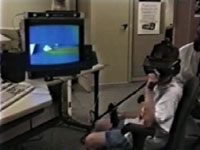American Psychiatric Association Institute - VR Therapy and Autism; Mayer Max
http://archive.psych.org/edu/other_res/lib_archives/archives/meetings/IPS/1999ips.cfm
American Psychiatric Association Institute, 1999
[Multimedia Session 8] VIDEO WORKSHOP: VIRTUAL REALITY THERAPY UPDATED.
Ian E. Alger, M.D., Multimedia Consultant, APA Institute Scientific Program Committee, and Clinical Professor of Psychiatry, New York Presbyterian Hospital-Cornell Medical Center, 500 East 77th Street, #132, New York, NY 10162; Donna Cunningham, M.A., O.R.T.; Larry Hodges, Ph.D.; Hunter Hoffman, Ph.D.; S. Marian Krishack, M.S.; Mayer L. Max, M.S.; Cheryl Trepagnier, Ph.D.; Suzanne Weghorst, Ph.D.
EDUCATIONAL OBJECTIVES: At the conclusion of this session, the participant should be able to show new advances in applications of virtual reality therapy in post-traumatic stress syndrome and stress and pain reduction in burn patients mitigated by virtual reality immersion.
SUMMARY: Expert researchers and clinicians from several of America's advanced research centers will demonstrate the most recent clinical applications in virtual reality. Larry Hodges, Ph.D., associate director of the College of Computing at Georgia Institute of Technology, will explore prospects for adaptive perceptual aids, and will demonstrate virtual reality environments for exposure therapy, exemplified by the "Fear of Flying" virtual reality program. Mayer Max, M.S., representing Vice President Gore's National Reinvention Initiative,and Cheryl Trepagnier, Ph.D., have assembled a special presentation, which gives two perspectives on virtual reality assessment of autism and ADHD. Mr. Max's program shows how children can reach into virtual reality through their desktop PC and robotics, and as the children establish a hands-on link with a "Robotic Wand Avatar," they can explore synthetic worlds--feel faces, bounce balls, and otherwise demonstrate their cognitive potentials. Key indicators may also begin to emerge on how best to combine the sensory channels of feeling, sight, and auditory navigation of information in virtual reality for simulation, training, or remote live teleoperation and projection of "presence".
A second impressive study by Cheryl Trepagnier will be presented by a group from the National Rehabilitation Hospital in Washington, D.C., on its work in regard to virtual reality and eye-tracking in the investigation of face-gaze in autism, with the use of a head-mounted virtual reality display in which a gaze-angle sensor is also installed. Coming from the Human Interface Technology Laboratory (HIT Lab) in Seattle, Washington, out of which flows a continuing stream of new ideas and application in virtual reality, Suzanne Weghorst, Ph.D., director of research, will demonstrate the prospects for "Adaptive Perceptual Aids." Hunter Hoffman, Ph.D., a research scientist from the same HIT Lab, will demonstrate "The Use of Immersive Virtual Reality to Reduce Burn Pain During Wound Care and Physical Therapy." In another application of virtual reality technology and principles in clinical work, Donna Cunningham, M.A., O.R.T., and S. Marian Krishack, M.S., will demonstrate the use of virtual reality in a novel and effective approach in physical rehabilitation.
REFERENCES:
1. Rothbaum BO, Hodges LF, Kooper R, et al: Effectiveness of virtual reality graded exposure in treatment of acrophobia. American Journal of Psychiatry 1995; 152:626-628.
2. Hoffman HG, Prothero J, Wells M, Groen J: Virtual chess: the role of meaning in the sensation of presence. International Journal of Human-Computer Interaction, in press.
3. Wiederhold MD: Cyberpsychology and behavior: the impact of the internet, multimedia and virtual reality on behavior and society. Mary Ann Liebert, Inc., 1998; Vol. 1, Number 3.
Previous page: Autism International Partnerships
Next page: New York Governor, Davos, Japan Symposia

